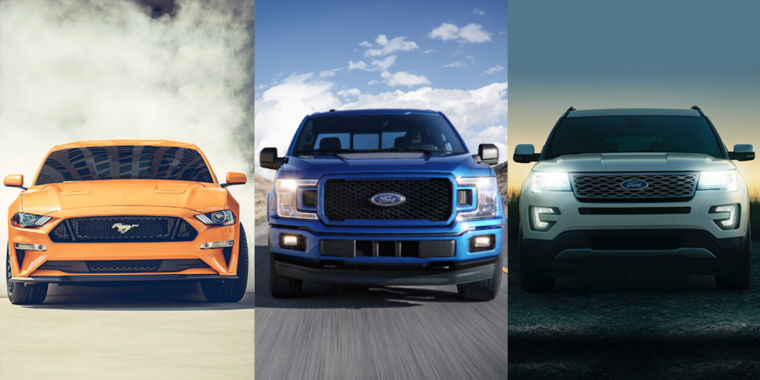
-
Ford is bringing hybrid versions of the Mustang, F-150, and Explorer.
-
This is an as-yet unnamed small SUV.
-
The all-new Ford Bronco will be one of eight SUVs in Ford’s North American lineup by 2020—and one of two off-road SUV offerings.
-
Ford will grow its lineup of performance SUVs. Two additions to the Ford Performance lineup include the all-new Edge ST later this year, and an Explorer ST will soon follow.
-
The Shelby GT500 will probably be the most powerful, quickest Mustang ever.
Ahead of this month’s New York International Auto Show, Ford released some info about its plans to adapt to the changing world of transportation. The Blue Oval says it’s “going all-in on hybrids,” including versions of the F-150 truck and Mustang sports car. The automaker is also readying six new battery electric vehicles by 2022, with the first due in 2020, and adding more performance versions of its SUV line up. Additionally, by the end of 2019, every new Ford will have 4G LTE connectivity, and the company is developing a new cloud platform that will deliver over-the-air updates.
New hybrids
“Hybrids for years have been mostly niche products but are now on the cusp of a mainstream breakout,” said Jim Farley, Ford president of global markets. “The valuable capability they offer—plus fuel efficiency—is why we’re going to offer hybrid variants of our most popular and high-volume vehicles, allowing our loyal, passionate customers to become advocates for the technology.” So America’s best-selling truck (the F-150) will get the ability to act as a mobile generator, something that should come in handy on job sites.
Meanwhile, the Mustang will have performance to match the 5.0L V8 version but with more low-down torque, according to Ford. The company says that these new hybrids will be cheaper and more efficient than its current hybrids, via “common cell and component design and by manufacturing motors, transmissions, and battery packs.”
But we’ll have to wait another two years for them to appear in showrooms; roll-out isn’t due until 2020.
New BEVs
We have to wait for those new BEVs, too. The first of these—an electric performance SUV—also shows up in 2020, but with five more planned between then and 2022. Ford says that it’s “rethinking the ownership experience” as part of this and that over-the-air software updates to add new features will be part of the $11 billion investment plan.
“Throwing a charger in the trunk of a vehicle and sending customers on their way isn’t enough to help promote the viability of electric vehicles,” said Sherif Marakby, vice president of autonomous and electric vehicles. “In addition to expanding our electric-vehicle lineup, we are redesigning the ownership experience to ensure it addresses customer pain points that currently hold back broad adoption today.”
On the subject of those OTA updates, I asked Ford how this would work and whether existing contracts with dealers would be an impediment. A Ford representative told me that “We already do OTA updates for SYNC 3, and, beginning 2020, new vehicles will be capable of OTA updates for the key modules and systems such as the powertrain and body control modules.”
More SUVs, more commercial vehicles, a super Mustang
Other new vehicles on the way include a reborn Ford Bronco SUV and an as-yet unnamed small SUV, but before then we’ll get redesigned Explorers and Escapes, due in 2019. Next year, Ford will also bring a new Transit van to the US, and it says advanced driver-assistance systems, like automatic emergency braking and others, will be added to future commercial vehicles like the future E-Series, F-650, F-750, and F59-based vehicles.
Among the images Ford released were shots of a range-topping Mustang variant, the Shelby GT500. Ford didn’t give us any details about it, but we expect it to take the Shelby GT350 as a starting point, except with more power courtesy of a supercharger. I had thought we might have seen the GT500 at the Detroit auto show earlier this year, but that turned out to be a Bullitt edition of the regular V8; Ford chose to show some journalists the GT500 at a separate event.
Haven’t we heard this before?
If you’re feeling a little déjà vu, you can be forgiven. I checked, and we did indeed report many of these announcements back in January 2017. Back then, Ford’s previous CEO, Mark Fields, said that the company was investing $4.5 billion in new BEVs (a figure that’s now $11 billion) and told us that electric versions of the Mustang and F-150 (as well as a police car, which we’ve seen) would be here by 2020.
It’s good that Ford remains serious about electrification, but it’s hard not to think the company is playing catch-up. By the time the first Ford long-range BEV goes on sale in 2020, the Chevrolet Bolt EV will be due for a mid-life refresh, and deadly rival GM plans on rolling out another two BEVs before the end of 2018 (with a total of 20 on sale by 2023).
Listing image by Ford
https://arstechnica.com/?p=1276431

